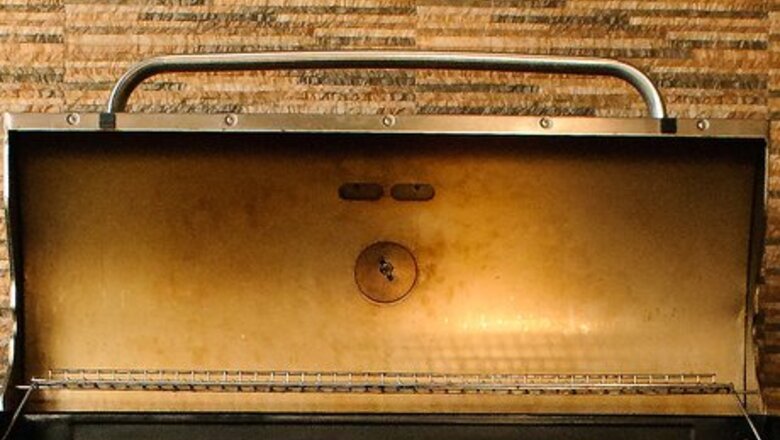
views
Smoker Basics
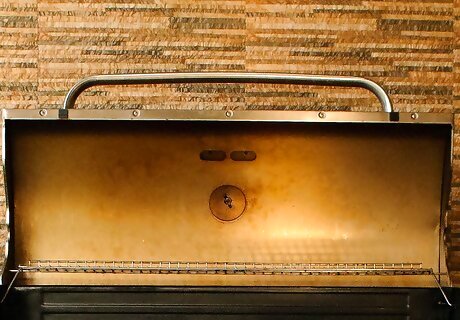
Choose a smoker. Meat smoking experts like to say that all you need to smoke meat is a hole in the ground. While that may be true, using equipment designed for smoking will make the process go a lot smoother and give you more reliable results. If you want to give smoking a try, but aren't sure if you'll do it more than once, you can use your charcoal grill to smoke meat. Otherwise, consider investing in one of the following types of smokers: A wood smoker. Wood smokers are known to produce the most flavorful results. They are fueled by hardwood blocks and chips, which impart their strong flavor to the meat you're smoking. Wood smokers can be tricky to use, though, because it's necessary to monitor them carefully and keep feeding them wood to keep the temperature steady. A charcoal smoker. This is a great choice for both beginners and experts. Charcoal smokers are fueled by a mixture of charcoal and wood. Charcoal burns longer and steadier than wood, so charcoal smokers are easier to use than wood smokers. You can create a charcoal smoker out of your backyard grill if need be. A gas smoker. These are easy to use—you don't have to monitor the temperature all day long—but the final product won't have as much flavor as meat smoked in a charcoal or wood smoker. Most BBQ chefs agree that a gas smoker creates a better flavor than an electric smoker, however. An electric smoker. With an electric smoker, you can put the meat inside, turn it on, and forget about it until the meat's done hours later. However, electric smokers won’t create as rich a flavor as other types, and they also tend to be pretty expensive.

Decide what type of wood to use. Meat can be smoked with a variety of different hardwoods, all of which impart a unique flavor to the meat. Some are stronger than others, and some pair better with certain types of meat. You can mix different types of wood that have properties you like. Depending on what kind of smoker you're using, you'll either need enough wood to burn all day long, or just enough to flavor the meat while charcoal, gas or electricity does the work. Choose from these options: Mesquite will give your meat a delicious but very strong smoky flavor. If you want to use only mesquite, use it with smaller cuts that won't have a very long cooking time. For bigger cuts that will require all-day cooking, mix mesquite with a milder type of wood. Hickory has a strong flavor that pairs best with red meat. Oak is good for cooking big cuts of red meat that need to smoke all day long, because its flavor is more subtle than that of mesquite or hickory. Cherry is a great complement for beef or pork. Apple wood has a sweet taste that's delicious with pork or poultry, and you can use it to smoke fish, too. Maple is another sweet wood that pairs well with pork or poultry. Alder is light and sweet, perfect for poultry or fish.

Use the wet smoking method for more temperature control. Water can be used to help control the temperature inside a smoker while the meat is cooking. In fact, some smokers are called "water smokers," and they're designed to incorporate water into the process. But you can smoke using water in a charcoal or wood smoker, too. All you have to do is put a pan of water inside the smoker and make sure it stays full throughout the day. Water smoking can help regulate the temperature when you're smoking a big cut of meat that will need to cook for many hours. For smaller cuts of meat that don't have a long cooking time, it's not necessary to use water. If you purchase a smoker, read the instructions before you decide to use water. Some smokers have a built-in water tray, while others will require you to add your own tray.
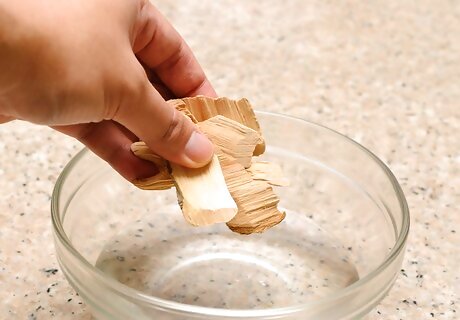
Soak wood chips, but leave bigger pieces dry. If you're working with a small charcoal grill or another type of smoker where you're not actually using the wood as fuel, you can use wood chips instead of big pieces. Since chips tend to burn up quickly, they need to be soaked in water so they last longer. Soak the chips for at least an hour, then wrap them in aluminum foil. Poke holes in the top so the smoke can get out. Bigger pieces, such as chunks and logs, can be left dry.
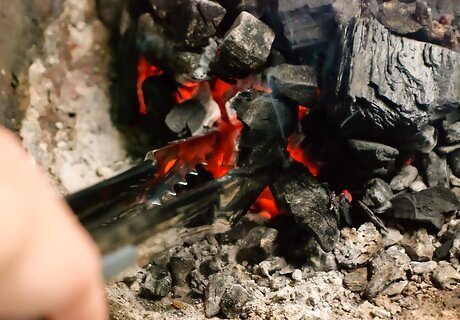
Follow the directions that came with your smoker to get it ready. Each smoker has different specifications as to how to get it ready to start smoking the meat. If you're using wood or charcoal as fuel, light up your materials in the grill and wait until they burn down and are no longer producing flames. Don’t place the meat directly over high heat; rather, push the coals aside so the meat cooks low and slow over indirect heat. Throughout the cooking process, you'll add more coals and wood to keep the smoker going. The goal is to keep the smoker in the range of 200–220 °F (93–104 °C) the whole time. If you have an electric or gas smoker, all you need to do is turn it on according to the manufacturer's instructions. Place your wood chips or pieces where they belong in the smoker—again, check the instructions to make sure you do it properly. You might want to invest in a thermometer you can keep inside the smoker to monitor the temperature.
Meat Preparation

Choose a type of meat to smoke. The smoking technique can be used on any type of meat, but it's usually best for tough cuts that need a long, slow cooking time. The slow cooking process breaks down the fat and connective tissue so that the meat becomes extremely tender. You also want to choose meat that will taste good with a smoky flavor. Here are a few types of meat that taste great smoked: Pork, especially ribs and shoulders. Beef, particularly briskets and ribs. Game meats, such as venison or boar. Oily fish, like trout, salmon, or mackerel. Poultry, such as whole chicken or turkey. However, keep in mind that poultry skin doesn’t always hold up well to prolonged smoking, and you might need to take it off before you eat the meat if it becomes too charred.
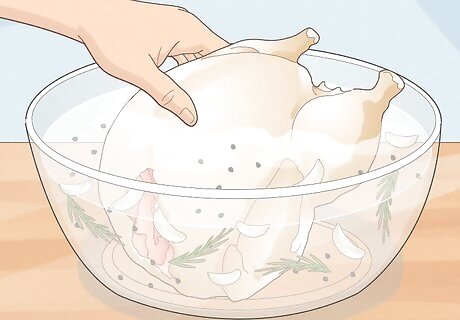
Brine poultry or ham to lock in moisture. Brining is often used on poultry before smoking to lock in moisture and boost the flavor. This is also a popular method for preparing ham before smoking it. Soak your meat in the brine overnight or for at least 8 hours in the refrigerator. Remove the meat from the refrigerator and bring it to room temperature before you begin the cooking process. To make a basic brine, use 4 tablespoons (70 g) of salt per 1 US quart (0.95 L) of water. Add extra seasonings to taste, such as garlic, pepper, rosemary, lemon rind, ginger, or sugar. If you’re cooking a cut of beef, such as a brisket, you can also marinate it to add flavor and tenderize the meat, but that is completely optional. A marinade is similar to a brine, but it contains acidic ingredients, such as lemon juice or vinegar.
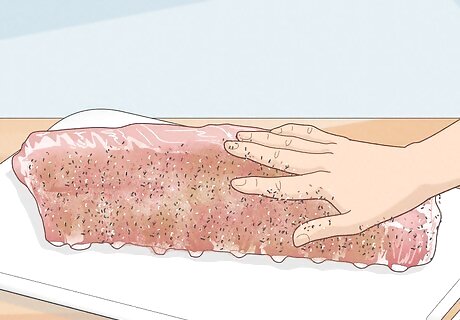
Add a dry rub to ribs for a flavor boost. Rubs are usually made with a combination of salt and spices. Apply the rub all over the meat and let it rest for a few minutes before cooking. To make a delicious but simple dry rub, combine these spices and seasonings: 1/2 a cup (144 g) of kosher salt 1/2 a cup (100 g) of brown sugar 1 tablespoon (10 g) of lemon pepper seasoning 1 tablespoon (7 g) of black pepper 2 teaspoons (2 g) of chili flakes

Bring the meat to room temperature before you smoke it. This is an important step to take before you begin smoking any type of meat. It will ensure that the meat cooks evenly and reaches the right internal temperature by the end of the cooking process. Depending on how large your cut of meat is, set it out on the counter about 1/2 hour to 2 hours before you begin smoking it. A thinner cut of meat, like a steak, won’t need as much time to warm up. 20-30 minutes is probably enough. For a larger piece of meat, like a big roast, a time closer to 2 hours may be more effective—but don’t sweat it if you can’t wait that long. To prevent the growth of dangerous bacteria, never leave meat sitting out for longer than 2 hours, and try to keep it in a relatively cool location. Don’t leave the meat sitting outside or in a hot room—e.g., where it’s over 90 °F (32 °C)—for longer than 1 hour.
Common Smoking Techniques

Calculate your cooking time. The length of time it will take to completely cook your meat is determined by the heat of the grill, the type of meat, and the size of meat cut. In most cases, plan on at least 6-8 hours of cooking time—and sometimes many more. Check your recipe to determine about how long your meat will need to smoke. Check your meat about 4 hours in to see if it’s done. If the meat is still firm, it needs to cook longer—smoked meat should be a bit limp and soft (but not falling apart at the touch) by the time it’s done. Pork and beef ribs typically take up to 8 hours, while a big cut of brisket could take around 20. It's very important to look at your recipe to figure out how long your meat might cook, so you can plan ahead. Some smaller or more delicate cuts of meat, such as fish, may cook in a much shorter time—e.g., in 1-3 hours.

Place the meat inside the smoker. Depending on the type of smoker you’re using, you can either place it directly on the grill or put it in a shallow aluminum tray. Don't wrap the meat in foil, though, because this won't allow the smoke to touch the meat. You want it to be able to surround the meat during the cooking process. The positioning of the meat will be different according to what you're cooking. If you're making a smoked brisket, for example, place the meat side down and keep the fat side up. Be sure the meat isn't over direct heat. As mentioned, if you're using your grill as a smoker, the hot coals should be scooted to the side of the grill so that the meat won't cook too quickly.

Baste the meat if necessary. Again, depending on what you're cooking, you might want to baste the meat to keep it moist throughout the cooking process. This technique is a popular choice for poultry, brisket, and ribs. Read the recipe you're using to decide if basting is necessary. If you cook your meat low and slow, it should come out moist and tender whether you baste it or not. To baste your meat, brush on your favorite marinade or sauce with a barbeque brush or mop. For safety, use separate batches of marinade for your initial soak and for basting your meat as it cooks. Don’t baste your partially cooked meat with a brush or mop that’s been used on raw meat.

Cover the meat if necessary. Some smoking recipes follow a "3-2-1" process: the meat smokes for the first 3 hours, then you cover it with foil for the next 2 hours, and finish it uncovered in the last hour. The smoke flavor infuses the meat first, then the meat warms up internally during the second 2 hours, and finally develops a nice thick crust to finish. Check your recipe to determine whether covering your meat at some point during the process is recommended.

Remove the meat when it reaches the right temperature. Monitor the temperature of the meat with a meat thermometer to determine its doneness. Poultry should reach 165 °F (74 °C). Any pork and all ground meats should be 160 °F (71 °C). The internal temperature of steaks, roasts, and chops should be 145 °F (63 °C).
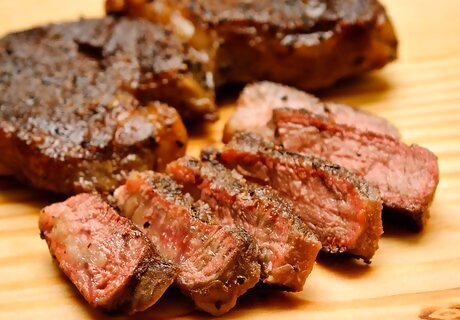
Check for the smoke ring. During the smoking process, a pink ring will form just underneath the delicious outer crust of the meat. This is a result of a chemical reaction that happens when the smoke infuses the meat; the pink color is caused by the formation of nitric acid. When you cut into your meat and see a pink smoke ring, you'll know that you smoked it right. If you use the color of meat to check its doneness, the smoke ring can be a little misleading. If you’re not sure whether you’re seeing a smoke ring or underdone meat, use a meat thermometer to check the internal temperature at the thickest part of the meat. A smoke ring can appear on most meats, including beef, pork, and poultry (such as chicken or turkey). You’re less likely to notice it in smoked fish.
Stovetop Smoking
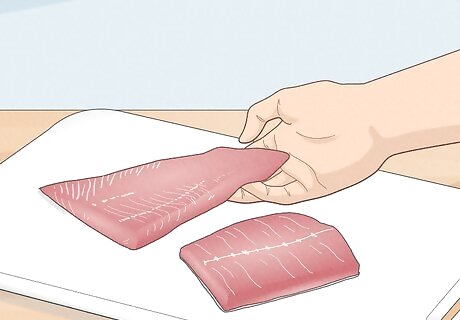
Use this technique for smaller, more delicate cuts of meat. You won’t be able to smoke a whole rack of ribs or a brisket on your stovetop. However, this indoor smoking technique works really well for things like fish, chicken wings, or smaller cuts of pork or beef. A wok smoker also works well for things like sausages, shrimp, and even some non-meats, such as squash or cheese.
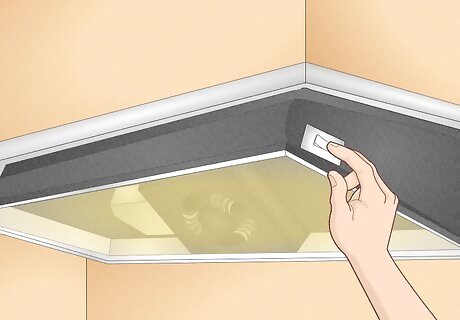
Turn on your vents and open a window. Smoking meat in your apartment or house can be tricky. To avoid filling your home with smoke, make sure your kitchen is well ventilated. If you have vents over your stove, turn them on. Open your windows and use a fan to help draw out some of the smoke.

Spread your meat on a wire cooling rack. Use a steel rack that’s not covered with a non-stick coating. If possible, get a rack that fits directly inside the top of your wok. Spread the meat out in an even layer on the rack. If you want, you can marinate the meat or add a dry rub before smoking it. If you use a marinade, let the meat soak for at least 1-2 hours before smoking it.

Line a wok with heavy duty aluminum foil. Use enough foil so that, if you set a wire rack on top of the wok, you can easily wrap the edges of the foil around the outer edges of the rack. Typically, an extra 5–6 inches (13–15 cm) of extra foil sticking out around the outside of the wok is enough. Press the foil down into the base of the wok instead of just loosely setting it inside.

Add a layer of white rice, green tea, and sugar to the bottom of the wok. You won’t be using woodchips or charcoal to smoke food indoors. Instead, use white rice and green tea, which will produce a delicate, flavorful smoke. Pour about 1/4 of a cup (46 g) of uncooked white rice into the wok, along with 1 teaspoon (2 g) of loose-leaf green tea and 1 tablespoon (12 g) of brown sugar. Other aromatic ingredients you can try include cinnamon, star anise, coriander, orange rinds, peppercorns, or fresh ginger.
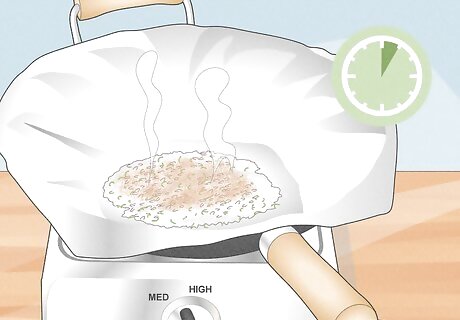
Heat the wok on medium-high for 5 minutes. Watch the smoking ingredients carefully. You’ll see the sugar start to smoke first. Once the rice and tea begin to smoke, it’s time to add the meat to the wok. Don’t leave the wok unattended! If you don’t act fast, your kitchen will quickly fill with smoke.

Set the rack on top of the wok. Ideally, it should be about 2 inches (5.1 cm) above the smoking rice and tea mixture. If the rack is too low, elevate it with some pieces of balled-up aluminum foil.

Cover the meat with a sealed tent of aluminum foil. Loosely cover the rack with foil, and use the edges of the foil lining the rack to seal it shut. This will help keep the smoke inside so you get the maximum amount of flavor in the meat (and your kitchen doesn’t get too smoky). Alternatively, place a large, domed lid on top of the wok. Wrap the edges of the foil around the lid to seal in the smoke. This will work best with a rack that’s designed to fit inside the wok.

Reduce the heat to low and cook for 10-20 minutes. For something like fish, 15 minutes is usually enough to cook it completely. Check the meat after about 10 minutes to see if it’s done to your liking. Cover it and cook it for another few minutes if it’s not ready. For some foods, such as larger cuts of poultry, you might need to cook the meat a little longer using a different technique, such as roasting or grilling. The food will retain the delicious smoke flavor from the wok. If you’re not sure whether the meat is ready to eat, check the temperature at the thickest part with a meat thermometer. Seafood, beef, pork, and lamb should reach an internal temperature of 145 °F (63 °C), while you’ll need to cook fresh or ground poultry to 165 °F (74 °C). Cook other ground meats to 160 °F (71 °C). Let the food sit for another 20 minutes after turning off the heat. This will help it soak up even more of the smoke flavor.

Purchase a stovetop smoker as an easy alternative. If you don’t have a wok, or if you’re looking for something a little more convenient, buy a stovetop smoker online or from a store that sells kitchen supplies. Many of these smokers work similarly to a wok smoker, but are designed with a built in rack and domed lid to seal in the smoke. Some stovetop smokers are designed to work with woodchips. Check the directions carefully to make sure you know what kind of fuel you can safely use in your smoker.
Gas Grills
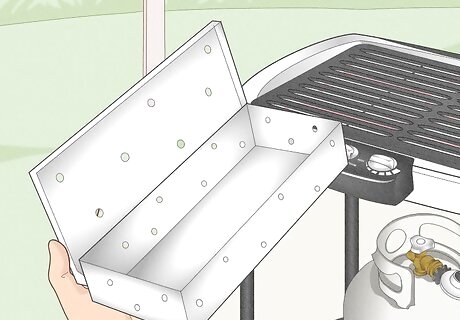
Get a smoker box for your grill. Gas grills don’t work as well for smoking as charcoal grills, but you can definitely make it work with the right equipment. Purchase a separate smoker box, or check to see if your gas grill comes with a built-in smoker box.

Fill the smoker box with soaked wood chips. Soak 6 cups (about 600 g) of wood chips in water for at least 30 minutes. Set aside an additional 2 cups (about 200 g) of wood chips, and leave those dry. You may need to add these in small amounts during the cooking process to keep the smoke going. Load the soaked chips into the smoker basket. Double check the directions with your smoker basket to make sure you can put wood chips in it. Some are designed to take other kinds of fuel, like wood pellets.
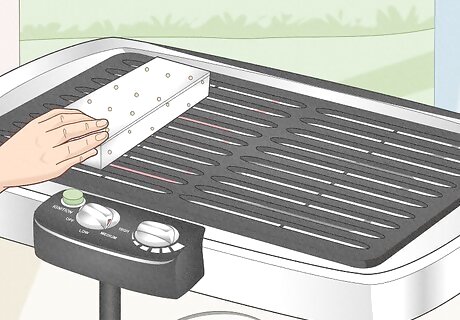
Light only 1 burner and place the smoker box over it. Don’t light all the burners in your grill, since you’ll be cooking your meat slowly over indirect heat. Light a burner at 1 end of the grill and place the smoker box directly above the flames. As the wood chips in the box warm up, they’ll start to burn and release smoke. Before you light up the grill, make sure the drip tray is empty so you don’t burn a lot of old grease. If your grill has 3 burners, light the ones at either end, but leave the one in the middle unlit. Don’t forget to check how much propane is in your grill before you start cooking! Since you’ll be smoking the meat for a few hours, it’s important that the tank is full.
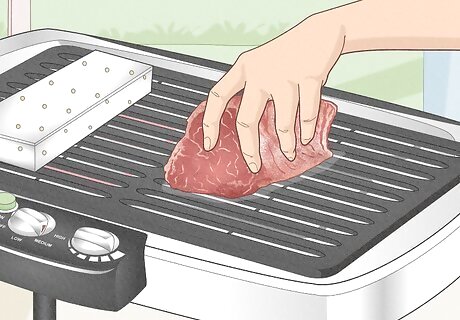
Place the meat on the other end from the box and shut the lid. If your grill has 3 burners, place the meat in the middle, between the 2 lit burners. Close the lid to trap the heat and smoke inside the grill. Check that the drip tray is positioned under the meat to catch any grease that falls.

Maintain the temperature of the grill around 225–250 °F (107–121 °C). Many gas grills come with a built-in thermometer so you can easily monitor the temperature of your grill. If the grill is reading too hot, turn the burner down. Keep adjusting the heat as needed. If your grill doesn’t have a built-in thermometer, slide a stand-alone grill thermometer in between the lid and base of the grill occasionally to check the temperature.
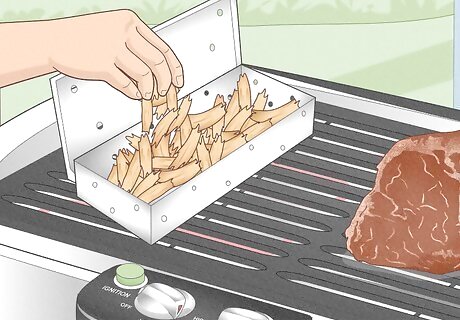
Add more wood chips every 45 minutes as needed. Every 45 minutes, open the grill to see if there’s still a good amount of smoke coming out of the box. If not, add about 1/2 a cup (50 g) of dry wood chips to the smoker box. Try not to open the grill any more often than you have to, since doing so will release heat. Follow your recipe to determine how long the meat needs to stay in the grill. It’s usually a good idea to test doneness after about 4 hours.
Firepit Smoking

Dig a hole that’s deep enough to contain your fuel and meat. Whether you’re camping out in the wilderness or roughing it in your own backyard, you can make delicious smoked meat outdoors with only a few, simple tools. If you don’t have a stone-lined earth oven or firepit, a simple hole in the ground will work just fine! Make your hole about 3 feet (0.91 m) wide by 3 feet (0.91 m) deep. Traditionally, fire pits for cooking have been lined with rocks. However, this isn’t strictly necessary for cooking simple firepit-smoked meat. Leave the soil that you dig out of a pit in a pile nearby—you’ll need to use some of it to cover your pit later! If you have a premade firepit or earth oven, the procedure is still basically the same. Just skip the digging part and get straight to building your fire!
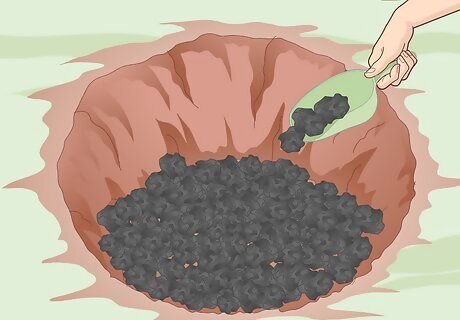
Add a layer of coals to the bottom of the pit. The easiest way to do this is to simply pour a layer of charcoal briquettes into the pit. However, you can also do it by placing firewood in the pit and letting it burn for 2-4 hours, or until the wood has been reduced to a pile of glowing embers. Your bed of coals should be at least 6 inches (15 cm) deep, although some outdoor chefs recommend making it as deep as 2.5 feet (0.76 m).

Light the coals and wait for the flames to die down. Use a small amount of charcoal lighter fluid to help get the fire going. Let the fire burn until your coals are glowing, but there are no longer active flames in the pit. To prevent any stray flames or sparks from burning the grass around the pit, wet the ground with a hose before starting the fire.
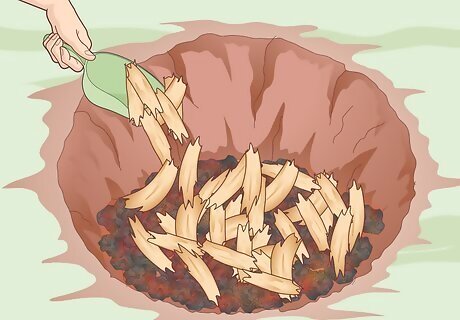
Place your preferred type of wood in the pit. Once you have a nice pile of embers, add a few wet sticks or chunks of wood to the top of the fire. Make sure the wood has soaked for at least half an hour before you add it to the pile so it doesn’t just burn up! Storebought firewoods like untreated almond, cherry, hickory, or mesquite are safe to use and will give your meat a delicious, smoky flavor. If you’re in the wilderness, you can harvest your own wood directly from surrounding trees, but don’t use pine. It’s full of resin that will create an unpleasant, thick smoke.
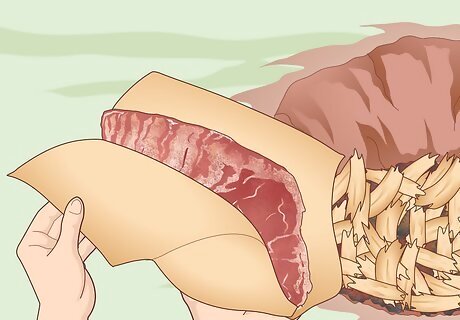
Wrap your meat in unwaxed brown paper. Butcher paper or a plain brown grocery bag will work. Add an extra layer of wet newspaper (make sure it’s plain, black-and-white newsprint!) around the outside of the bundle to help seal it up completely. This will help lock in moisture and keep dirt and ash out of your meat. Alternatively, wrap your meat in fresh banana leaves. Set the bundle in an aluminum roasting pan with .5 inches (1.3 cm) of water in the bottom to help keep the meat moist and the cooking temperature stable.
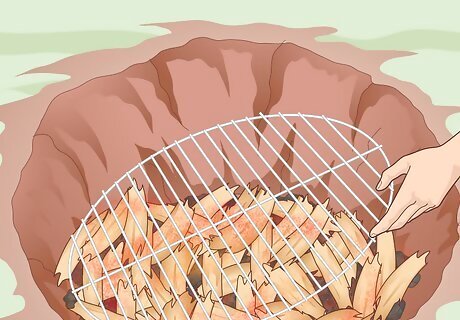
Lay a grill rack or a grid of sticks on top of the fire. If you have a metal barbeque grill rack that fits in your pit, carefully place it on top of your pile of coals. Alternatively, take some thin, green sticks, such as aspen branches, and lay them over the coals in a grid pattern to create a platform. If you do this, soak the sticks for at least 30 minutes first so that they don’t burn up! Another option is to place a layer of rocks and banana leaves over the coals.

Put the meat on the grill and cover the hole with a board. Carefully lower the wrapped meat into your barbeque pit. To avoid burning yourself, you might want to put on some oven mitts or heat-resistant gloves. Next, put a lid over the pit, such as a large plank of wood or sheet of metal. To seal in the smoke and heat, layer on an old blanket or sheet as well. Cover the whole thing with the dirt left over from digging your pit.
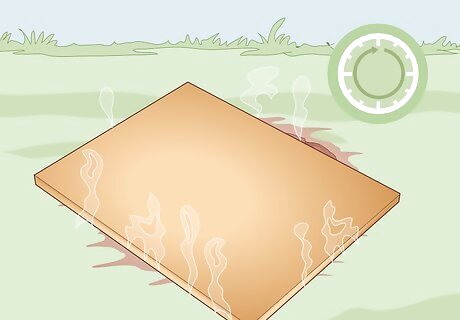
Allow the meat to cook for several hours. Depending on what you’re cooking, you may need to leave your meat in the pit overnight. When you think it might be ready, uncover the pit and carefully reach in—wearing oven mitts or protective gloves—and pull out the meat. When you unwrap it, it should be tender, moist, and deliciously smoky! Depending on how big the piece of meat is, it might not be completely done when you take it out. If you’d rather not wait several more hours, you can always finish cooking it using some other method, such as roasting it in a regular oven. If you’re not sure whether the meat is done, check it with a meat thermometer. Cook beef, pork, lamb, or seafood to an internal temperature of 145 °F (63 °C), and poultry to an internal temperature of 165 °F (74 °C).




















Comments
0 comment